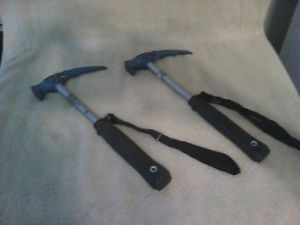Back to the main page Back to category Other Climbing and Caving
watch details
Ice Hammers COLLECTIBLES MESSNER & HABELER First oxygen-less ascent Mt.Everest
Estimated price for orientation: 975 $
Category: Other Climbing and Caving
Class:
Description Country/Region of Manufacture: Austria
The following Events that took place in 1978,Led to these Commemorative Ice Hammers being produced in 1979. Maybe the most significant Commemorative Mountain climbing item produced to this day.Rare to find One,let alone a complete Pair.Climbing Mount Everest, the tallest mountain in the world, was a challenge that eluded scores of great mountaineers until 1953, when Sir Edmund Hillary and Tenzig Norgay first reached its summit. Over the next three decades, more "firsts" followed, including the first ascent by a woman, the first solo ascent, the first traverse (up one side of the mountain and down the other) and the first descent on skis. But all of these climbers had relied on bottled oxygen to achieve their high-altitude feats. Could Mt. Everest be conquered without it?As early as the 1920s, mountain climbers debated the pros and cons of artificial aids. One, George Leigh Mallory, argued "that the climber does best to rely on his natural abilities, which warn him whether he is overstepping the bounds of his strength. With artificial aids, he exposes himself to the possibility of sudden collapse if the apparatus fails." The philosophy that nothing should come between a climber and his mountain continued to have adherents fifty years later. In the 1970s, two of its strongest proponents were Reinhold Messner and Peter Habeler. Messner had achieved considerable notoriety by completing a series of spectacular Alpine rock climbs without the use of metal protection pegs. In 1974, Messner teamed up with Habeler, a quiet Mayrhofen guide who shared his philosophy, and the pair proceeded to take the climbing world by storm. Agile and slight of build, they scaled the Matterhorn and Eigerwand faces in record time. In 1975, they made a remarkable ascent of the 11th highest mountain in the world, Gasherbrum, without using supplemental oxygen. By 1978, they had set their sights on climbing Mt. Everest—without bottled oxygen. Messner and Habeler now faced exhaustion unlike any they'd encountered before. Every few steps, they leaned on their ice axes and gasped for breath. Messner described feeling as though he were going to "burst apart." As they climbed higher, they fell to their knees and even lay down in an effort to recover their breath.Sometime between 1 and 2 in the afternoon on May 8, 1978, Messner and Habeler achieved what was believed to be impossible—the first ascent of Mt. Everest without oxygen. Messner described his feeling: "In my state of spiritual abstraction, I no longer belong to myself and to my eyesight. I am nothing more than a single narrow gasping lung, floating over the mists and summits." "In my state of spiritual abstraction, I no longer belong to myself and to my eyesight. I am nothing more than a single narrow gasping lung, floating over the mists and summits."
Description
| Country/Region of Manufacture: | Austria |
The following Events that took place in 1978,Led to these Commemorative Ice Hammers being produced in 1979. Maybe the most significant Commemorative Mountain climbing item produced to this day.Rare to find One,let alone a complete Pair.Climbing Mount Everest, the tallest mountain in the world, was a challenge that eluded scores of great mountaineers until 1953, when Sir Edmund Hillary and Tenzig Norgay first reached its summit. Over the next three decades, more "firsts" followed, including the first ascent by a woman, the first solo ascent, the first traverse (up one side of the mountain and down the other) and the first descent on skis. But all of these climbers had relied on bottled oxygen to achieve their high-altitude feats. Could Mt. Everest be conquered without it?As early as the 1920s, mountain climbers debated the pros and cons of artificial aids. One, George Leigh Mallory, argued "that the climber does best to rely on his natural abilities, which warn him whether he is overstepping the bounds of his strength. With artificial aids, he exposes himself to the possibility of sudden collapse if the apparatus fails." The philosophy that nothing should come between a climber and his mountain continued to have adherents fifty years later. In the 1970s, two of its strongest proponents were Reinhold Messner and Peter Habeler. Messner had achieved considerable notoriety by completing a series of spectacular Alpine rock climbs without the use of metal protection pegs. In 1974, Messner teamed up with Habeler, a quiet Mayrhofen guide who shared his philosophy, and the pair proceeded to take the climbing world by storm. Agile and slight of build, they scaled the Matterhorn and Eigerwand faces in record time. In 1975, they made a remarkable ascent of the 11th highest mountain in the world, Gasherbrum, without using supplemental oxygen. By 1978, they had set their sights on climbing Mt. Everest—without bottled oxygen. Messner and Habeler now faced exhaustion unlike any they'd encountered before. Every few steps, they leaned on their ice axes and gasped for breath. Messner described feeling as though he were going to "burst apart." As they climbed higher, they fell to their knees and even lay down in an effort to recover their breath.Sometime between 1 and 2 in the afternoon on May 8, 1978, Messner and Habeler achieved what was believed to be impossible—the first ascent of Mt. Everest without oxygen. Messner described his feeling: "In my state of spiritual abstraction, I no longer belong to myself and to my eyesight. I am nothing more than a single narrow gasping lung, floating over the mists and summits." "In my state of spiritual abstraction, I no longer belong to myself and to my eyesight. I am nothing more than a single narrow gasping lung, floating over the mists and summits."
